
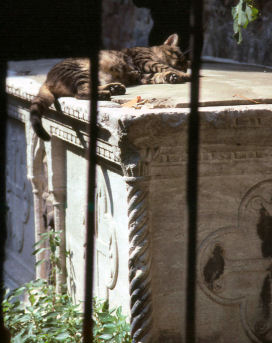 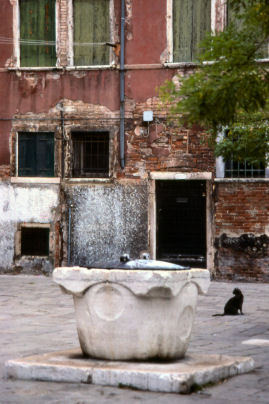 Having mentioned the cats of Venice and their many related mysteries so often in my trip reports I thought that it would be good to bring these strands together in one place. Having not been to Venice since 1992 I was surprised on my 2002 visit to find that the large number of friendly strays living in many campi (sometimes in little makeshift wooden huts) and being fed foil dishes of pasta by old ladies had all disappeared, completely. The small garden in front of San Zaccaria, the Garibaldi Gardens, the wide canal-side area behind the Scuola Grande di San Rocco - all areas that seemed very empty without their resident tabbies. This seemed to me to be a somewhat tragic loss, as Venice was justly famous for its cat population. And where had they all gone? This top part of this page features photos I took in the early 90s, when the cats were many. Further down you'll find more recent bulletins. 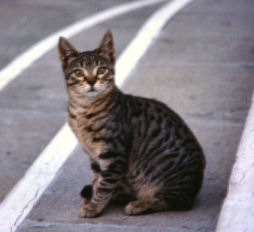 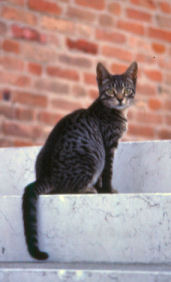 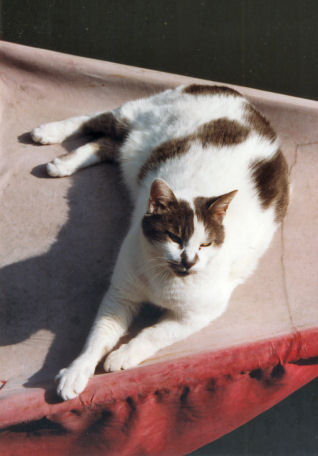 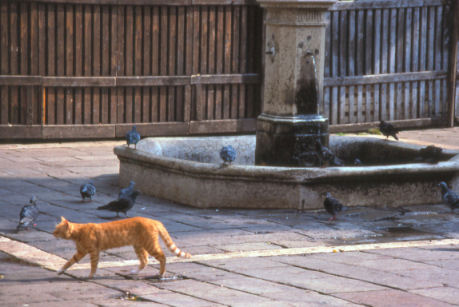
|
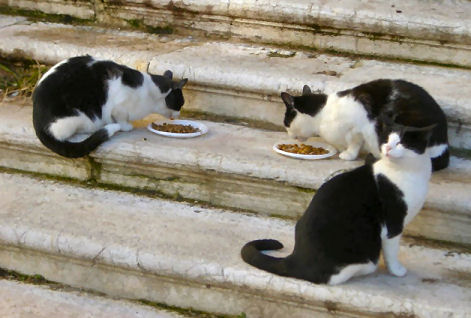 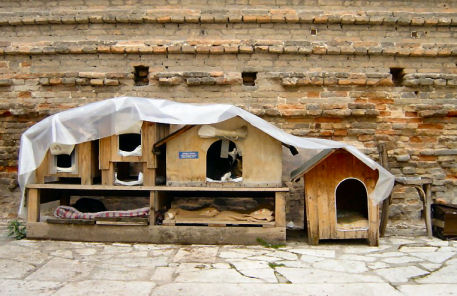 Then in
December 2006
came reports of new sanctuaries. Anne Atwell wrote to me of a
discovery by the church of San Lorenzo in Castello on a winter trip. Then in
December 2006
came reports of new sanctuaries. Anne Atwell wrote to me of a
discovery by the church of San Lorenzo in Castello on a winter trip. "I walked up to the front of the church and saw all of these little houses......it was a cat sanctuary! It was a cold morning, and I could see all these little faces inside staring at me. A couple of them came out to check me out, but most stayed in. The houses are nice and have pillows inside......there was a bowl of water and bunch of empty paper plates all over the steps of the church." She went back later with a box of cat biscuits and made 11 new friends. Yonnie, a non-furry friend of hers, took these two photos. Anne also passes on reports of two more sanctuaries, one in the gardens close to Piazzale Roma as well as one in Cannaregio, reputedly somewhere between the Ospedale and Bacini vaporetto stops. There are also rumours of another one near the Greek church. It seems that these new homes are being provided by Dingo, but as they don't seem to have a web site it's hard to check. Any further info would be appreciated, but I'll surely be having a scout round on my next visit, in March 2007. |
|
2007 |
||
|
On my trip in March 2007 I found the San Lorenzo huts, looking a little less appealing than in the photo above, with fly-blown plates all around, and old fish heads, which was a bit unsavoury. Only two cats too, including the rolling-over tabby to the right. However passing through later in the week there was someone feeding and tidying up and more cats, so they still thrive, it seems. Didn't find any of the other little sanctuaries, though, but more wandering cats were spotted than in any recent years, especially up in Cannaregio, which is good news. And here's a (now historical) link to a posting on Trip Advisor about the 2007 state of Dingo and visiting the cat sanctuary. |
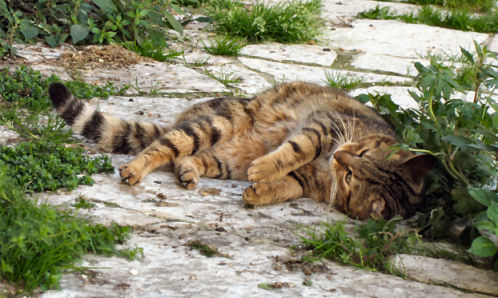 |
|
|
Then in
August 2007
I
got an e-mail from Jan Waldron reporting on the San Lorenzo colony. She
wrote: Last weekend I stayed in an apartment right next to the church on the square and can report that the cat colony is currently up to 20 cats, although around 6 hang out there during the day time. Including the cats pictured on your site - I counted 20 late at night, including the big tabby tom. A lady came at about 9am and put cat food down on paper plates and there were bowls of water (one of which was in the doorway to the building half way along on the right hand side (a school?). They all looked relatively healthy, but were very wary of people in general. They're still using the little wooden house, which still seemed quite weather-proof thankfully. I was glad to see that the locals are looking out for the cats. She also sent some photos, of the sanctuary (right) and some other local residents (below). Is the cat peering down from the wall the same cat as the rolling-over tabby tom in my photo above? |
|
|
|
|
|
|
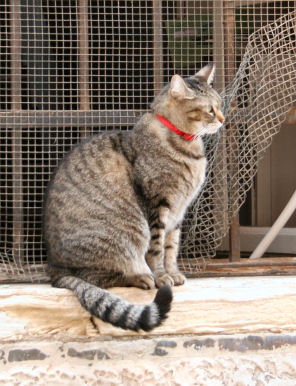 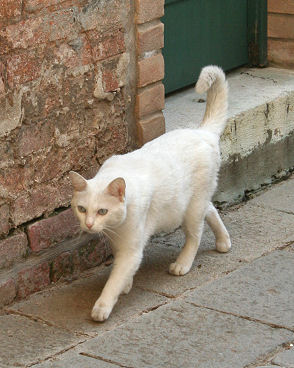 My trip in October 2007 added nothing to the store of knowledge, but I took some nice photos. I can report, though, that the campo in front of San Lorenzo is now totally free of diggings and hoardings. I'd tried to make contact with Dingo before I went but their e-mail address failed. 
|
||
|
|
||
|
March 2008 brings an e-mail from webmeister Thomas Grones with the news that Dingo have a new web-site www.dingovenezia.it (and it works!) and that an English version is coming soon. Lucky old Gail Woodcock was in Venice again in April 2008 and writes to say: I have just returned from a few days visit to Venice and thought you would welcome an update on the cats at San Lorenzo. They were all looking reasonably well, fit and active except for the black cat without the white smudge under its chin. It seemed to have a gammy eye but otherwise it did not seem too bad. Rather than drinking the water in the blue bowl provided for them, they seemed happier drinking the rain water that had collected on the tarpaulin covering their 'home'. There was no sign of any food being left for them, but there were plenty of fat pigeons at the bridge end of the Campo feeding on bread rolls, so I guess the cats could partake of an occasional pigeon if need be. And who's to know where the rats and mice hang out locally? By the way, the green patch to one side of their home is green with grass and weeds as all the cats seem to use it 'in lieu of pussy litter'. She also attaches one of her sweet collages (right). |
|
|
 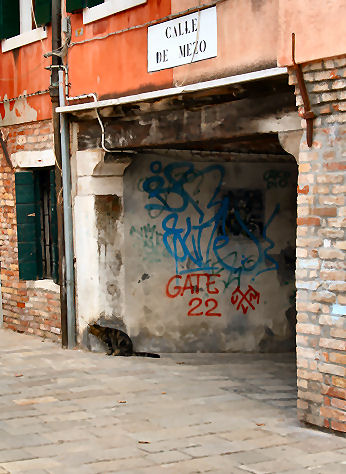 In April 2008 I made contact with Dingo! An e-mail to the new address got me a reply, and confirmation that the English version of the site, with a Paypal donations option, is coming soon. They also sent me a Word document in English setting out their work, which you can open by clicking here. In October 2008 I visited Venice myself. My visit to the San Lorenzo colony was somewhat curtailed by a stupid woman who brought her aggressive little dog, which wasn't on a lead, to chase the cats (including the worse-for-wear tabby favouring his right back leg, pictured right) despite her shouting at it. I spotted (and stroked) a few (presumably non-feral) cats around the campos during the week, but not as many as in previous years, although the weather was colder. In a neighbourhood food shop, buying a cake, I noticed some lost-cat posters on the counter and asked the owner about them. He said that more pet cats than ever were disappearing. He was a firm believer in the Chinese restaurant theory saying that cats, and small dogs, were being stolen to appear on menus in the city. I've heard this one before, as an explanation for the disappearance of the feral cats, but have always put it down to prejudice and/or a taste for melodrama, but he was adamant, saying that the cats can hardly run away from an island criss-crossed by canals, or be run over by a car. I'm still not so sure, if only because Venice has so few Chinese restaurants and anti-Chinese racism, even in the mainstream press, is sadly not uncommon there.  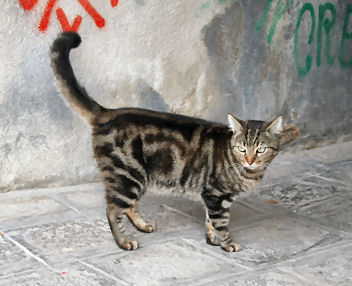 |
||
|
|
||
 April 2009 April 2009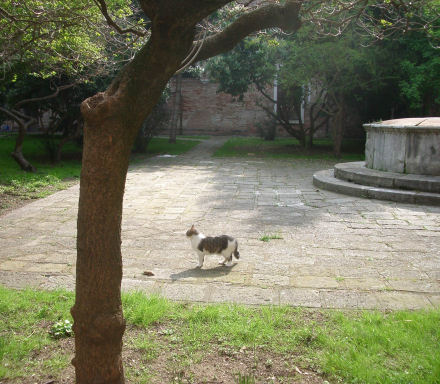 The Dingo colony rumoured to be near the Ospedale by San Zanipolo is actually in the Ospedale grounds, and so not accessible to the general public. Michelle Lovric was taken to see them by a portera and reports the usual hutches and ladies coming to feed them every evening. She took a couple of photos too, as well as the one (below) of the rusty tabby having a stretch near the Miracoli church. 
|
||
|
August 2009 Below is a new montage from Gail W. showing the San Lorenzo posse doing what they do best and two from Brigitte Eckert. 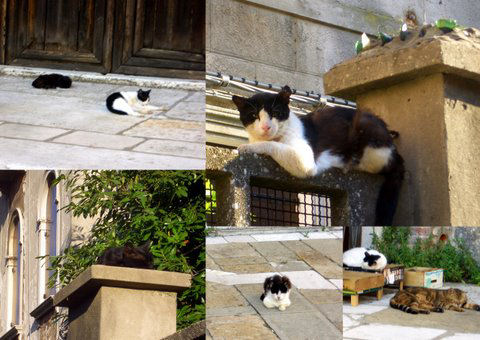
|
||
 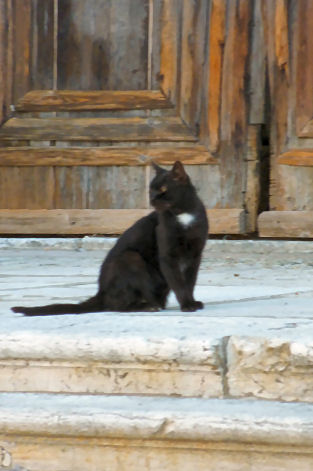 September 2009 My 2009 trip. A pair of dozing San Lorenzo cats and a wandering black cat.
|
||
|
|
||
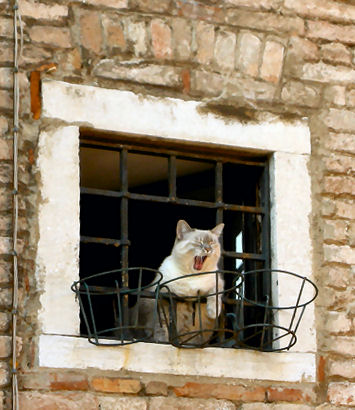  March 2010 New correspondent Francesco Gamba gets the year off to a somewhat belated start with the yawning laundry cat (left) from around the back of San Nicolò dei Mendicoli.
May 2010
|
||
|
September 2010 Just before my Autumn trip a report (and a photo right) from (a different) Michelle, from New Zealand on the San Lorenzo colony. The ailing boss-tabby with the gammy leg is still ailing, it seems, but surviving. Do Dingo ever get vets to visit, she wonders? Or ever reply to emails? |
|
|
|
mid-September 2010 I checked out the above Michelle's reports of the ricketyness of the boss tabby, who was hobbling last time I visited, and the time before that. However, an emaciated- looking tabby that was far from sure-footed may be the cat she means, and the boss tabby I was thinking of was not in evidence. Or is it the same cat after some drastic weight loss? This scraggy tabby did seem bosom buddies, though, with a black cat with whom he seemed inseparable (left). Spotted a couple of Dingo cabins on Torcello and a good few cats on Burano (like the two below and the one on the blue boat) many romping near the vaporetto stops.
|
||
|
|
||
|
July
2011 Correspondent Karin, who visited Venice in June, writes and sends some nice photos of the San Lorenzo cats, and she too wonders if they get any vet care at all. The boss tabby (below) still has a gammy mouth, it seems, and looks more rickety as the years pass. But he survives.  I wrote to Dingo to see what was up with the treatment of the San Lorenzo cats, and their very old promise (of March 2008!) of an English language version of their website. No reply so far. But Gail, who has written before, writes to say that she'd been in Venice... ...this year in the early Spring and in June for the opening week of the Biennale. Each time I checked on the cats of San Lorenzo and in particular the old tabby Tom. After a visit late last year, I thought I had seen the last of him as he was looking very ill and fragile. But blow me when I went back this spring and again early summer, he was a new cat except for a bit of arthritis which did not stop him jumping up on the window ledges. The other cats (only counted 5 or 6 now) are very attentive and caring of him. One of their little ‘hutches’ has been painted to look like a house with windows, curtains and flowers. And Robin Saikia, author of the excellent book on The Venice Lido is promising to donate €3 for every copy of his book he sells online from his website here. I might just take advantage of his contact with the Malamocco/Lido cattery on my next trip too. |
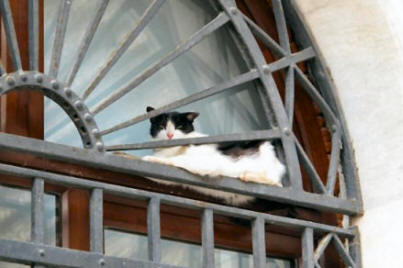
|
|
|
August 2011 An email from Thomas Rautenberg, who lives in Germany but is a frequent visitor to Venice and who provides the photos for the Dingo calendar. I paste the email below as he has many sensible and informative things to say about Dingo's work and methods...
They try to keep the cat population in good
health. Cats with e.g. a dangerous virus they isolate in Malamocco. They
try to keep the population not higher than arround 2000 cats (Venice +
islands). Without controlling the birth rate Venice would have about
10.000 - 12.000 hungry slim cats. I heard different opinions from locals
whether Dingo should do that or not. Personally I think they are right. A
feral cat in Rome normally doesn't get elder than 3 years. In Venice
sometimes they live 10-15 years. Enough food, no cars ... and Dingo. |
|
|
|
|
||
|
November
2012 A lean year for updates, and a rare non-visiting year for yours truly. But the year has seen the long-awaited and long-doubted-ever-in-our-lifetimes opening of the church of San Lorenzo. It's been granted to Mexico for use as their Biennale venue, the condition of which is that they carry out restoration. To what degree of finish and accessibility this restoration is to be carried out is to be seen. There are more photos of the church's state internally in the entry for San Lorenzo on my Churches of Venice site. The downside of this development, however, is that the Dingo huts have been reduced to one and it has been forced down the steps and off to the side, but the cats remain, as shown in these photos taken by Brigitte Eckert and (below right) Val de Furrentes. And we can now safely assume, I think, that the boss tabby photographed in past years has now gone to that bowls-of-tuna-filled campo in the sky. 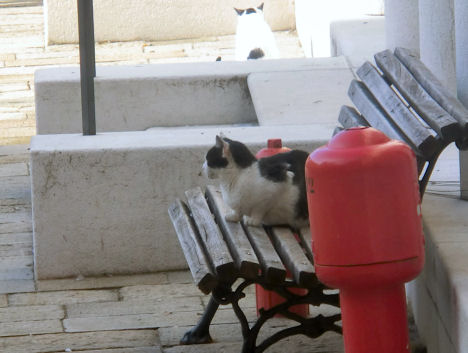 |
|
|
|
|
||
|
June 2013 Reports from Campo San Lorenzo are a little depressing. Gail W sends a collage (below) writing to say that it seems that there are now only three cats left. Also that they were grateful for some fresh water as their food and water bowls were empty and it looked like they were not being well cared for. Any further investigation and reports welcome.
|
|
|
 |
|
|
|
|
||
|
September 2013 On my first visit to Venice since 2011 I saw more cats in Cannaregio, where I was staying, than in previous years. Which was heartening and just as well, as the thinning of the San Lorenzo posse was less heartening. |
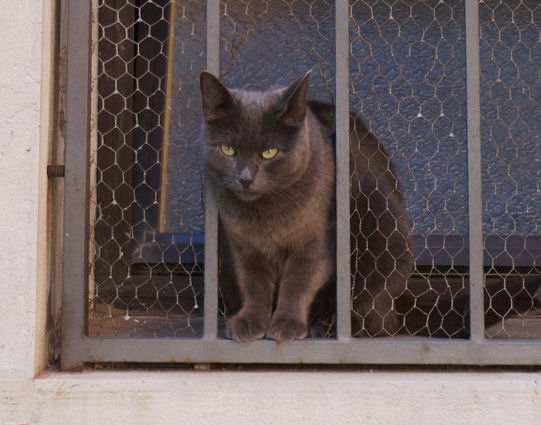 |
|
|
|
||
|
December 2013 The year ends with some montages and reports from Gail W. The San Lorenzo cats, still down to the core black and white trio, have had some plastic roof and door coverings installed for the winter, it seems, so they can now peer mysteriously out through plastic curtains. 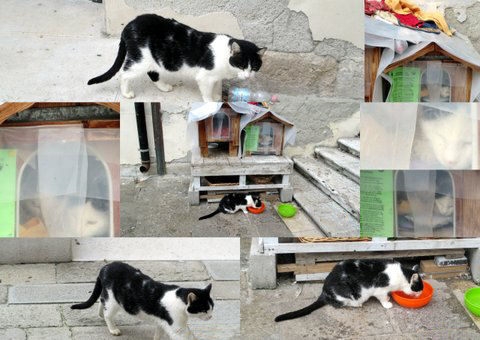 |
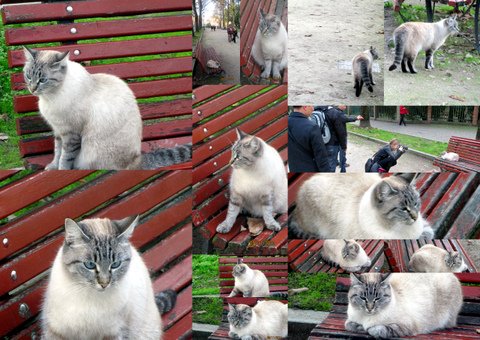 She also tells of the above handsome chubby poseur in the Garibaldi Gardens. He would walk sedately down the Viale and every time he came to a bench he would jump up and pose on the left hand side for about 5 minutes whilst passers-by took photos before jumping down and walking very deliberately and regally along to the next bench and repeating the performance. In all, I watched him do this on four different benches over about 30 minutes. |
|
|
|
||
|
March
2014 An impromptu week booked to see some exhibitions and stuff. Another good trip for interacting with the cats of Cannaregio, including the two huge tabbies (Maine Coons?) living in the ex-boatyard. The kittenish tabby-and-white living in the courtyard by my hotel entrance that I photographed in September is still around and still a friendly sweetie. Although he rarely posed anywhere that doesn't include rubbish or unphotogenic building materials. My only passing through Campo San Lorenzo was on a wet day though, and the trio there were all sensibly sheltering. |
|
|
|
June 2014 A shop window in Barbaria delle Tole by Brigitte Eckert Later in 2014 this sign was snapped by Gail W. in Campo San Lorenzo... 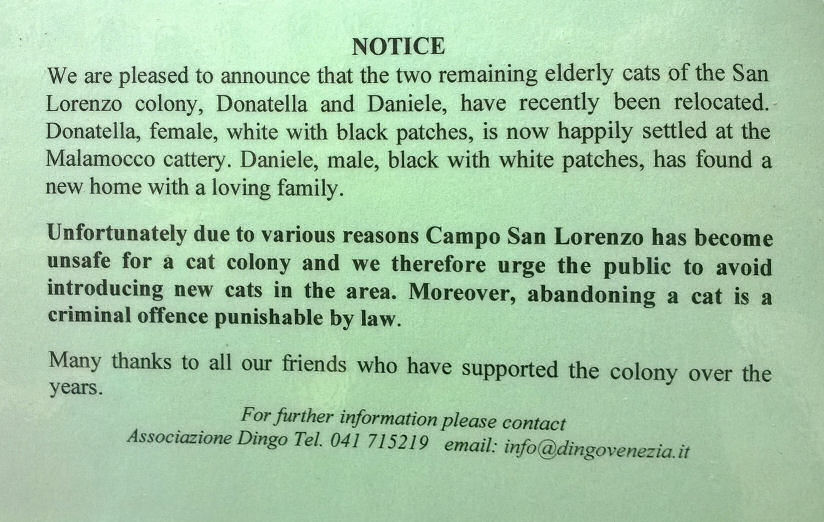 ...which is good for Donatella and Daniele, but a bit sad for the rest of us. |
||
2015-16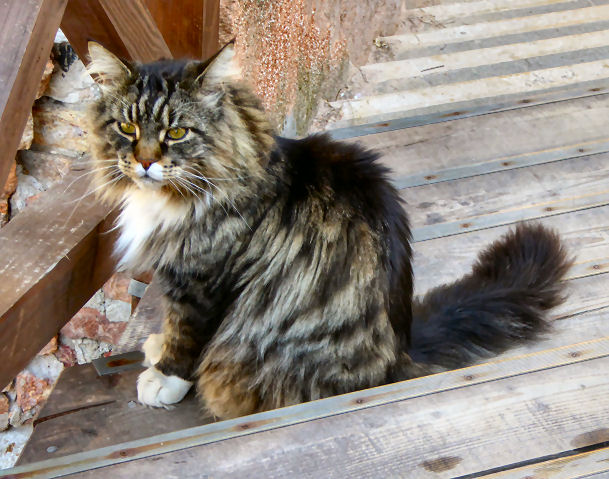
 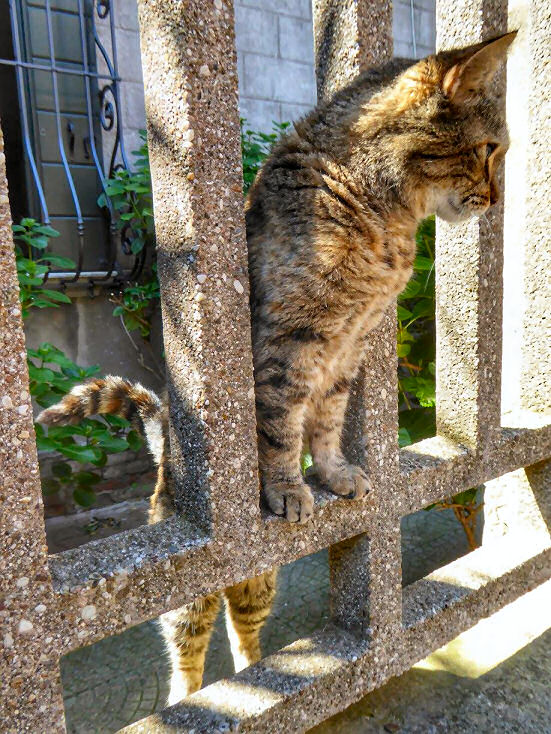 A Time of Tabbies, with the poseur above showing that there are still cats around the flats next to Campo San Lorenzo |
||
|
2017 A visit in the cold wilds of January didn't result in any cat sightings, unsurprisingly. |
||